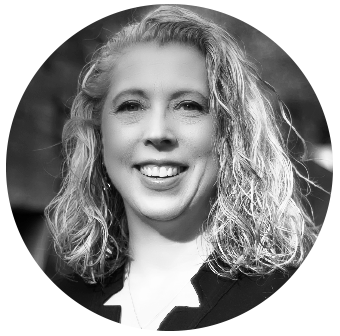
y favorite color is black. Besides its slimming effect, it is the color of the void. In the void lies all possibility and change. In the void lies the future.
I have grave concerns about climate change and the growing inequality that future generations will face, but I also have great hope. I believe that collectively we have the ability and the responsibility to construct a better future for the next generations. That construction will require change, and a lot of it. While change might make some people cringe, I find it invigorating.
To be successful as a professional, as a parent and as a citizen, I must work on today’s issues but also focus on what is going to happen tomorrow. Similarly, we, as a locality, region, state, nation and global community, need to be looking forward and prepared for shifts that will determine our prosperity in the coming years.

Photos by Britteny Cioni-Haywood
y favorite color is black. Besides its slimming effect, it is the color of the void. In the void lies all possibility and change. In the void lies the future.
I have grave concerns about climate change and the growing inequality that future generations will face, but I also have great hope. I believe that collectively we have the ability and the responsibility to construct a better future for the next generations. That construction will require change, and a lot of it. While change might make some people cringe, I find it invigorating.
To be successful as a professional, as a parent and as a citizen, I must work on today’s issues but also focus on what is going to happen tomorrow. Similarly, we, as a locality, region, state, nation and global community, need to be looking forward and prepared for shifts that will determine our prosperity in the coming years.
As an economist, I am fascinated with how the economy is changing. The economy is rapidly undergoing a structural shift. Economic conditions are changing how our markets and industries function. There are numerous technological advances that are converging today to create these structural shifts. Electric and autonomous vehicles, Lithium-ion batteries, solar and other alternative energies are providing synergy to shift our transportation and energy sectors. The Transportation-as-a-Service model will further disrupt the transportation sector and change city landscapes as less space for vehicles is needed. Blockchain is changing currencies and accounting and will shift our financial sector. Artificial intelligence, machine learning and nanotechnology will change more than we can imagine right now.
The economy is an evolving social construct. We are seeing a push to move from cradle-to-grave design toward a circular economy. Most production waste is due to a design process that does not address the waste streams. Designing for the use of those waste products leads to a more efficient and cleaner process. For example, sugar beet processing can be designed to produce animal feed, electricity, liquid CO2, limestone, and concentrated yeast protein in addition to sugar products as well as recover valuable topsoil.
I often ask myself, What does all this mean today and for the next generations? I always have more questions than answers, but I know that the next generations will see change at an unprecedented rate. The industrial revolution took roughly 80 years. The change from horse and buggy to the automobile took about 13 years. The change from film to digital photography took less than a decade. Seven years ago, electric buses were considered a joke; today, the Chinese are adding approximately 9,500 electric buses every five weeks as a solution to their transportation and pollution issues. New projects are in the works to develop electric ships and airplanes. We are developing and adopting technology at a faster rate than ever before. This allows for disruption to continue as synergies are developed with different technologies to create even more innovation and change.
It is quite possible that my seven-year old child will never learn to drive, not because he won’t want to but because he won’t need to. His car will be autonomous and electric, likely powered by what is currently an alternative energy source and stored in advanced batteries. This example scenario poses many questions. What skills should I help my son develop? What will be the jobs of the future? It is estimated that 65% of today’s children will have a job that has yet to be created. Currently, there is much focus on teaching children to code. While my son might need an understanding of coding, with artificial intelligence and machine learning it is highly likely that machines will be better at coding than humans before he reaches the job market. The workplace of tomorrow will demand a higher level of agility, as workers will likely change not only jobs but entire careers in response to changes in technology, automation, artificial intelligence and machine learning. I believe that today’s children need a solid traditional education, but they also need strong skills in critical thinking, creativity, collaboration and adaptability. To help develop these skills, I integrate Fermi questions, unstructured play, and coping techniques into my son’s routines.
Change leads to emerging sectors and innovation. Economists refer to the process of dying and emerging industries as creative destruction. I contend that there will not be a single industry that will not face disruption or destruction to varying degrees throughout the next 20 years. There is major disruption already occurring in the oil and gas, transportation, agriculture, manufacturing, and financial sectors, and there is no turning back. Market forces will drive much of the change that is coming. I look forward to these disruptions and the hard work that will be required to build resilient, adaptable and efficient systems. I don’t believe that technology will save us; I believe that our ability to collaborate, solve problems and apply our creativity will save us. Technology is simply a tool that encompasses these abilities.
I have been fortunate to spend the last few years working directly on economic development. I know that economic development is best focused on growing existing businesses and industries. I have termed this “growing our own.” By strengthening the business environment, we support the people who want to be in a community and operate their business in that area. As entrepreneurs create new opportunities, the economy expands and dynamic economies are created. For this growth to occur it is extremely important to break down silos and create strong networks. There are connections that are critical to the success of the entire system. Institutions can come together to solve challenges and create a vibrant system that supports growth, entrepreneurial efforts and innovation. We will need strong institutions and relationships to solve the problems that we face today and tomorrow.
Innovation demands visionaries who will ask hard questions: “Why are we doing this?" "What would work better?” “How do we solve this problem?” The visionaries ask these questions, but everyone plays a part in the creation of a vibrant system. We need the support of many to bring innovation to life. This includes investors, skilled and unskilled workers, smart governments, and even families.
Synergy and timing are key aspects of innovation. The convergence of supporting technologies is necessary. Solar power is being supported by the improvement of battery technology and other products. Economic development needs workforce development, and workforce development must be supported by economic development; one cannot happen without the other. Synergy also demands that we break down silos. We must recognize the important roles that different sectors play in the innovation process, including those visionaries and risk takers, venture and other private capital sources, human capital and government. We must have the collaboration of smart people to build synergetic relationships.
I have learned that, above all else, it is always about relationships. Making sure they are not parasitic but symbiotic. One skill I know that I need to teach my child is the ability to create and build strong and healthy relationships. This is something that I believe will not change and will become even more important in the future. We need to build relationships that are strong enough to withstand the change that is going to take place. It is strong relationships that will allow us to prepare the next generation for the jobs they will hold, whatever those jobs may be. It is strong relationships that will allow us to prosper in the future. It is strong relationships that will allow us to move through the void.
